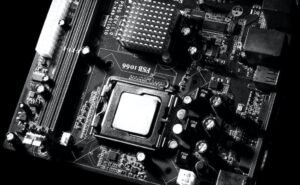AI Cybersecurity Issues
As artificial intelligence (AI) continues to advance, it is transforming the field of cybersecurity. While AI offers significant advantages in detecting and responding to cyber threats, it also introduces new challenges and risks. In this article, we will explore some of the key AI cybersecurity issues.
Key Takeaways:
- AI cybersecurity presents both benefits and challenges.
- Human oversight is crucial for effective AI-based cybersecurity systems.
- Attackers can exploit AI systems and use them as tools for cybercrime.
- The ethical implications of using AI in cybersecurity are significant.
The Advantages of AI in Cybersecurity
AI provides several advantages in the field of cybersecurity. *Using machine learning algorithms, AI systems can analyze huge volumes of data and identify patterns that humans might miss.* This enables security professionals to detect and respond to threats quickly and accurately. Additionally, AI can automate routine tasks, such as patching software vulnerabilities, freeing up human resources for more complex cybersecurity work.
A further advantage is AI’s ability to continuously learn and adapt. This allows AI systems to evolve and improve over time, staying ahead of emerging threats. With real-time threat intelligence and automated incident response, organizations can strengthen their cybersecurity posture and enhance their ability to defend against cyber attacks.
Challenges and Risks of AI in Cybersecurity
While AI brings numerous benefits to cybersecurity, it also introduces new challenges and risks. It is important to note that AI is not immune to cyber attacks itself. *Hackers can manipulate AI algorithms and models, leading to the compromising of security systems.* This creates a constant battle between attackers and defenders, as both leverage AI technologies to gain an advantage.
An additional challenge is the lack of ethical considerations in AI cybersecurity. Since AI systems can now make autonomous decisions, the issue of accountability arises. *Ethical questions arise, such as whether it is fair to hold AI accountable for mistakes or malicious actions, and how to ensure AI systems do not violate privacy rights.* These concerns require careful thought and regulation to prevent potential abuses.
AI Cybersecurity Training and Human Oversight
Proper training and human oversight are crucial when implementing AI in cybersecurity. Organizations must ensure that their AI models are trained on high-quality, unbiased datasets to prevent discriminatory or incorrect decision-making. *Human experts are needed to verify the outputs of AI systems and intervene when necessary.* Additionally, cybersecurity professionals need to continuously update their skills to keep pace with the evolving AI threat landscape.
Human intervention is also essential for interpreting and acting upon the outputs of AI systems. While AI can provide valuable insights and recommendations, human judgment is essential for making key decisions and taking appropriate actions. Striking the right balance between human expertise and AI capabilities is vital in achieving effective AI cybersecurity.
Tables with Interesting Data Points
| Type of AI Cybersecurity Attack | Examples |
|---|---|
| Data poisoning | Creating biased training data to manipulate AI systems. |
| Adversarial attacks | Manipulating AI models to misclassify inputs. |
| Model stealing | Extracting information from AI models to replicate or exploit. |
| Benefits of AI in Cybersecurity | Challenges of AI in Cybersecurity |
|---|---|
| Enhanced threat detection and response | Potential manipulation of AI algorithms by attackers |
| Automation of routine tasks | Lack of ethical considerations in AI cybersecurity |
| Continuous learning and adaptation | Issue of accountability in autonomous AI decisions |
Conclusion
AI brings valuable advancements to the field of cybersecurity. Its ability to analyze vast amounts of data, automate tasks, and continuously learn makes it a powerful ally in defending against cyber threats. However, it also introduces new challenges and risks, such as potential manipulation by attackers and ethical considerations. To maximize the benefits of AI in cybersecurity, proper training, human oversight, and robust ethical frameworks are necessary.

Common Misconceptions
Misconception 1: AI is 100% foolproof in Cybersecurity
One common misconception surrounding AI in cybersecurity is that it is infallible and can completely eliminate all risks. While AI systems have advanced capabilities in threat detection and mitigation, they are not immune to vulnerabilities or false positives.
- AI systems can make mistakes in recognizing new and evolving threats.
- Human hackers can manipulate AI algorithms and exploit their weaknesses.
- AI may have difficulty distinguishing between legitimate user behavior and abnormal activity, leading to false alarms.
Misconception 2: AI will replace human cybersecurity professionals
Another misconception is that AI will replace or render human cybersecurity professionals obsolete. While AI has the potential to automate certain tasks and enhance efficiency, it cannot replace the critical thinking and decision-making abilities of human experts.
- Human professionals provide a contextual understanding that AI may lack.
- AI requires human oversight and intervention to interpret and act upon its findings.
- Human professionals are needed to handle complex and novel cybersecurity incidents that AI may not be able to handle effectively.
Misconception 3: AI can fully predict and prevent all cyberattacks
Many people assume that AI can accurately predict and prevent all cyberattacks. While AI can analyze patterns and detect anomalies, it cannot guarantee the prevention of all cyber threats.
- AI relies on historical data and existing patterns, making it susceptible to new and unknown threats.
- Cybercriminals can adapt their techniques to evade AI-based defenses.
- There are limitations in detecting insider threats and social engineering attacks that heavily rely on human manipulation.
Misconception 4: AI in cybersecurity is a one-time implementation
Some people believe that implementing AI in cybersecurity is a one-time effort that will provide long-lasting protection. However, AI systems require continuous updates, maintenance, and learning to stay effective.
- Threat landscapes evolve rapidly, requiring AI models to be regularly updated to adapt.
- New vulnerabilities and attack vectors emerge, necessitating ongoing training and improvement of AI algorithms.
- AI systems need to be regularly audited and tested for biases or unintended behaviors.
Misconception 5: AI can solve all cybersecurity problems instantly
Lastly, some people have the misconception that AI can instantly solve all cybersecurity problems once deployed. However, implementing effective AI-based cybersecurity measures takes time, resources, and a comprehensive strategy.
- AI implementation requires careful planning, integration, and testing to ensure compatibility with existing cybersecurity infrastructure.
- Generating accurate AI models and training data is a time-consuming process.
- AI is not a standalone solution and should be used in conjunction with other cybersecurity measures.

Introduction
As AI becomes more advanced and pervasive, it brings with it a range of cybersecurity challenges. This article delves into ten interesting aspects of AI cybersecurity issues, shedding light on various concerns and highlighting the need for robust protection measures.
Data Breaches by AI-Powered Malware
AI-powered malware has become increasingly difficult to detect, leading to a surge in data breaches. In 2019 alone, there were over 1,500 reported breaches caused by AI-driven attacks.
Risk of AI Algorithms Manipulation
AI algorithms are vulnerable to manipulation, posing a serious threat to both individuals and organizations. A study found that 78% of companies experienced at least one incident involving algorithm manipulation in the past year.
Increased Sophistication of Phishing Attacks
AI has empowered phishing attacks by enabling highly personalized and convincing messages. Reports show that AI-powered phishing attacks are 49% more successful in evading detection compared to traditional phishing attempts.
AI-Generated Fake News
AI can automatically generate convincing fake news, leading to misinformation and social instability. Studies estimate that approximately 30% of all information shared online is AI-generated fake content.
Quantum Computing and AI Hacking
The rise of quantum computing poses a significant risk to AI cybersecurity. Quantum computers would have the potential to break current encryption methods, leaving sensitive data vulnerable to hacking.
Exploiting AI Facial Recognition Systems
AI-enabled facial recognition systems can be manipulated, leading to privacy breaches and unauthorized access. In a recent experiment, researchers successfully fooled a facial recognition system with a 3D-printed mask.
AI-Enabled Automated Botnets
AI is increasingly being utilized to create automated botnets that can launch large-scale cyber attacks. These botnets can easily overwhelm network defenses, causing extensive damage. In 2020, the largest AI-powered botnet attack recorded reached a peak of 2.5 terabits per second.
Differential Privacy in AI
Differential privacy techniques are essential for protecting user data in AI systems. A survey reveals that only 32% of AI developers implement differential privacy measures, leaving vast amounts of data at risk.
Misused AI for Automated Spear Phishing
AI technology has been misused for automated spear phishing, significantly increasing the effectiveness and reach of these attacks. In a study, organizations reported a 70% increase in successful spear phishing incidents after attackers began leveraging AI techniques.
The Need for AI-enabled Cybersecurity Solutions
With AI playing a critical role in both cyber attacks and defense, it is imperative to develop AI-enabled cybersecurity solutions. The future lies in AI systems that can proactively identify and address potential vulnerabilities before they are exploited, ensuring a safer digital landscape for all.
Conclusion
AI cybersecurity issues present a myriad of challenges that require urgent attention. From data breaches to the manipulation of AI algorithms, the potential risks are significant. However, by harnessing the power of AI in cybersecurity defenses, we can mitigate these threats and foster a safer environment for both individuals and organizations.
AI Cybersecurity Issues – Frequently Asked Questions
Question: What is AI cybersecurity and why is it important?
Answer: AI cybersecurity refers to the use of artificial intelligence techniques and technologies to protect computer systems and networks from cyber threats. It is important because traditional approaches to cybersecurity are becoming less effective against sophisticated attacks, whereas AI can detect, prevent, and respond to threats in real-time, thus enhancing the overall security posture.
Question: How does AI help in detecting and preventing cyber threats?
Answer: AI systems can analyze large volumes of data, network traffic, and user behavior patterns to identify potentially malicious activities. Machine learning algorithms can learn from past instances and make predictions about new threats. This helps in detecting and preventing cyber threats by automatically recognizing and responding to anomalous behavior or known attack patterns.
Question: What are the limitations of AI in cybersecurity?
Answer: AI systems are not foolproof and have their limitations. They can be vulnerable to adversarial attacks, where malicious actors exploit the weaknesses of AI models to evade detection. Additionally, AI may generate false positives or false negatives, leading to errors in threat detection. Human expertise and oversight are still crucial in evaluating and interpreting AI-generated insights.
Question: How does AI contribute to enhancing incident response and recovery?
Answer: AI automates incident response processes by providing real-time alerts, automated threat analysis, and guided investigation workflows. It can quickly identify the scope and impact of an incident, facilitate timely containment and remediation actions, and assist in post-incident forensics analysis for better recovery and learning from the attack.
Question: Are there any ethical concerns associated with AI cybersecurity?
Answer: Yes, there are ethical concerns related to AI cybersecurity. These include the potential for AI to unintentionally discriminate against certain individuals or groups, invade privacy, or be used by malevolent actors to conduct cyberattacks. Transparency, accountability, and ethical governance frameworks are necessary to address these concerns and ensure responsible use of AI in cybersecurity.
Question: Can AI be hacked or misused for malicious purposes?
Answer: AI systems can be vulnerable to hacking or misuse. Adversaries can manipulate data inputs to deceive AI algorithms or exploit vulnerabilities in the AI infrastructure itself. Malicious actors could also leverage AI techniques to create advanced, autonomous attacks. Securing AI systems against such threats requires robust safeguards, data integrity measures, and continuous monitoring.
Question: How can AI assist in vulnerability management and patching?
Answer: AI can help in vulnerability management and patching by automating the process of identifying vulnerabilities in software and systems. It can analyze security advisories, vulnerability databases, and system logs to prioritize and recommend patches or mitigation strategies. AI can also predict potential future vulnerabilities based on historical patterns, helping organizations proactively address emerging threats.
Question: What are the implications of AI in the workforce within the cybersecurity domain?
Answer: AI will transform the cybersecurity workforce by automating repetitive tasks, augmenting human decision-making, and enabling security analysts to focus on higher-level tasks. However, it may also displace some job roles that can be automated. Upskilling and reskilling of personnel to work effectively alongside AI systems will become crucial to harnessing its potential and addressing evolving cybersecurity challenges.
Question: How secure is AI technology itself from cyber threats?
Answer: AI technology, like any other software, can have vulnerabilities that can be exploited by cyber attackers. Adversaries can tamper with AI training data, infiltrate AI models to manipulate outcomes, or launch attacks on AI infrastructure. Protecting AI technology involves securing the underlying algorithms, training data, model updates, and access controls to prevent unauthorized use or tampering.
Question: Are there any regulations or standards governing the use of AI in cybersecurity?
Answer: Currently, there are not many specific regulations or standards solely focused on AI in cybersecurity. However, existing regulations and frameworks such as the General Data Protection Regulation (GDPR) and the NIST Cybersecurity Framework provide guidance on privacy, data protection, and cybersecurity best practices, which can be applied to AI-powered cybersecurity systems.




